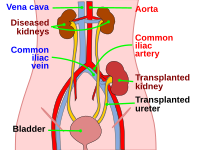
Photo from wikipedia
The increasing prevalence rate of end-stage renal disease (ESRD) has emerged as a global health burden. Peritoneal dialysis (PD) possesses the survival and convenient advantage for ESRD during the first… Click to show full abstract
The increasing prevalence rate of end-stage renal disease (ESRD) has emerged as a global health burden. Peritoneal dialysis (PD) possesses the survival and convenient advantage for ESRD during the first 2 years of dialysis treatment. However, long-term PD and hyperglycemia have been identified to frequently result in peritoneal fibrosis (PF) as subsequently to lead the failure of peritoneal function. Therefore, how to prevent PF is an important issue, especially in diabetic ESRD patients. To explore the effective protection in PD patients, Taiwan National Health Insurance Research Database was utilized to conduct the retrospective population-based cohort study from 1997 to 2013. A total of 19,828 diabetic ESRD patients with PD were analyzed the incidence of PD failure in the user and nonuser of dipeptidyl peptidase-4 (DPP4) inhibitors. On the other hand, the pathological role of DPP4 was further verified by cellular model and animal model of PF induced by chlorhexidine gluconate (CG). The rate of PD failure was significantly lower in diabetic ESRD patients with than without receiving DPP4 inhibitors (p<0.0001). Among all collected types of antidiabetic drugs, diabetic ESRD patients with DPP4 inhibitors treatment had the lowest rate of PD failure. In cellular study, the high concentration of glucose induced the increase of DPP4 protein levels, accumulating with the epithelial–mesenchymal transition (EMT), inflammation and the generation of oxidative stress in the mesothelial cells. However, sitagliptin treatment remarkably suppressed high concentration of glucose-inducing cellular damage. Additionally, in vivo study, sitagliptin treatment significantly decreased DPP4 activity, reversed EMT process via attenuating TGF-β/ Smad3 axil, ameliorated angiogenesis, reduced oxidative stress generation and inflammation through inhibiting NF-κB/ MyD88 signaling, followed by protected peritoneal integrity and function against CG-inducing PF in rats. DPP4 contributed to the peritoneal fibrosis and functional impairment, whereas DPP4 inhibitors were suggested as a clinical protective strategy for extending PD. Figure:
Journal Title: Nephrology Dialysis Transplantation
Year Published: 2020
Link to full text (if available)
Share on Social Media: Sign Up to like & get
recommendations!